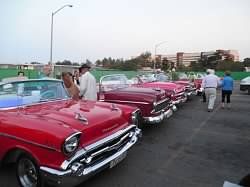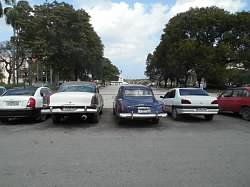Classic Cars of Cuba – Observations

 I went to Cuba for a two week vacation in February of 2015. I went because it is warm there and it is very cold in Pittsburgh at that time of year. That is not the only reason, but it was the main reason.
I went to Cuba for a two week vacation in February of 2015. I went because it is warm there and it is very cold in Pittsburgh at that time of year. That is not the only reason, but it was the main reason.
As I get older, it seems that I am unable to take the cold like I did when I was younger. Now I know you Canadians can go to Cuba anytime you want, but it is different for us Americans. It is kind of like the fruit of the forbidden tree. Bonnie and I went with a travel company that has some kind of exemption to the travel ban for educational reasons.
During the visit, we met with representatives of the Cuban government to talk about the relations between America and Cuba. (Remember this was pre-President Obama’s visit). I learned things about the embargo that I did not know before. For instance, if a foreign ship docks in a Cuban port, it is not allowed into an American port for a period of six months. If a corporation does business with Cuba, they are not allowed to do business in the US.
 That is why there are no new foreign cars in Cuba except Russian ones. If Toyota sold cars in Cuba, America would not let them sell cars here. That is why you see all the old American cars still running in Cuba. We had a chance to ride in a few and to talk to the drivers and owners. Our guide told us that Cuban mechanics are also known as “magicians”. They have changed the drive train in a lot of these cars to diesel engines. We went to dinner one night in a 1947 Chevrolet that was given to the driver to take care of when the owner left Cuba after the revolution. The original owner died, and now the car belongs to the driver. At least he thought so.
That is why there are no new foreign cars in Cuba except Russian ones. If Toyota sold cars in Cuba, America would not let them sell cars here. That is why you see all the old American cars still running in Cuba. We had a chance to ride in a few and to talk to the drivers and owners. Our guide told us that Cuban mechanics are also known as “magicians”. They have changed the drive train in a lot of these cars to diesel engines. We went to dinner one night in a 1947 Chevrolet that was given to the driver to take care of when the owner left Cuba after the revolution. The original owner died, and now the car belongs to the driver. At least he thought so.
I was told that there is a MGA in Cuba. Tim Coyne, past NAMGAR Chairman, even took some parts to him for his car some years ago. Randy Grossman, our Advertising Manager, wanted me to find the owner but I was unable to make contact. After I got home, I saw that Barney Gaylord has a lot of information of the owner on his MGA Guru website.
Cuba was an interesting trip. The people were all glad to see you, and it was warm there in February. The main reason I went!


Comment by: Richard Green
Great reading George. We went with Insight Cuba for 8 days in 2012 and then with Friendly Planet for 5 days in 2014. Never saw an MGA but saw a TF in front of our hotel, the Nacional.
You explained something we learned on the trip as well, and glad you did. I always had wondered how the country was so far behind when they have always been able to business with the rest of the world. Can’t wait to go back next year. Here’s a link to the pic of the TF we saw. If you scroll thru the album you’ll see a lot of the other cars. I love the one where I’m looking down on an intersection near the capitol building and see a group of cars at a stop light.
https://photos.google.com
https://photos.google.com
Comment by: Richard Green
Great reading George. We went with Insight Cuba for 8 days in 2012 and then with Friendly Planet for 5 days in 2014. Never saw an MGA but saw a TF in front of our hotel, the Nacional.
You explained something we learned on the trip as well, and glad you did. I always had wondered how the country was so far behind when they have always been able to business with the rest of the world. Can’t wait to go back next year. Here’s a link to the pic of the TF we saw.
https://photos.google.com
https://photos.google.com
Comment by: Howard Perks
When we visited Cuba a few years ago we were told that families who owned cars (and property) pre the revolution could keep them. Post-revolution there were no new cars to be had for the proletariat thus making the early vehicles very precious and worth keeping going no matter what it took. Indeed the state owned everything from that event.
If you didn’t own car a pre-revolution then bad luck. Only officials, doctors and others with government connections (mainly those who had made a big commitment to the communist party) or proof of foreign exchange income were allowed to purchase new imported cars (usually Russian). Everyone else had to make do with buying, selling and refitting cars made before Fidel Castro took power in 1959.
We hired a car and under numerous highway bridges standing in the shade would be a man in a white coat herding a line of people. He would stop any car with empty seats (unless it had a hire or government registration plate) and let some of the bystanders into the car until all the seats were full. The point being that it was the state who actually owned the car, even if you had bought and paid for it, and consequently it had to be shared with any other citizen who needed to get somewhere. They would make a contribution to the gas cost.
In some ways this is an admirable form of car sharing with all the attendant advantages for those not able to have their own car or who want to cut down on their carbon footprint. However, it is hard to imagine many private car owners in the west being happy about having to allow anyone off the street to share their private vehicle which they had bought with their hard-earned money.
Comment by: Ted Persons
I visited Habana during May of 2014. The visit was educational business and certified under current travel requirements. The sanctioned trips are under a variety of cultural, educational, and other People to People types of programs. Study Abroad programs have been entering Cuba for several years.
There are a variety of Japanese as well as European cars on the road, although comparatively few. I saw a new Audi in front of a major hotel that “floored” me. Its amazing how many 40’s and 50’s American cars are on the road, right up to 1962, then, stop, nothing afterwards. I recall a 51 Ford with a Nissan engine, five speed on the floor and a truck gear shift, etc. Most of the cars have been converted with what ever can be sorted to replace the old machinery that can no longer be supported. There are a lot of truck and tractor parts that have found there way into the cars. There is other trade except for the US.
One of our group spotted a red MGA, but I missed it. I did see other old British cars such as Morris and Mini. The Lada’s seemed to be worse off than most of the old American cars, probably because of the pride in keeping the American vehicles running and looking as good as possible. I didn’t really make note of the newer cars but they seemed to be Japanese. Saw a few old Mercedes as well.
A beautiful island with a long and rough history that goes back to its Spanish settlement.
By the way, I was astounded when I recognized the brand, but Mexican Coca Cola was on the shelves of cafe’s
Safety Fast,
Ted
Comment by: Michael Tooke
Great article…entertaining and informative at the same time!
Comment by: Peter & Anne Tilbury
Great article, George. No doubt your visit precipitated the visit by President Obama.